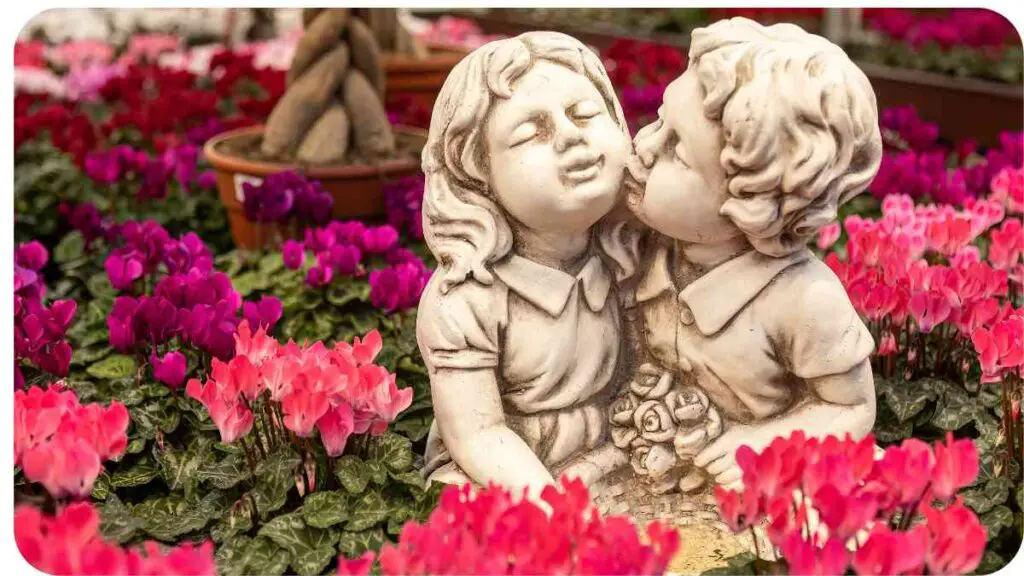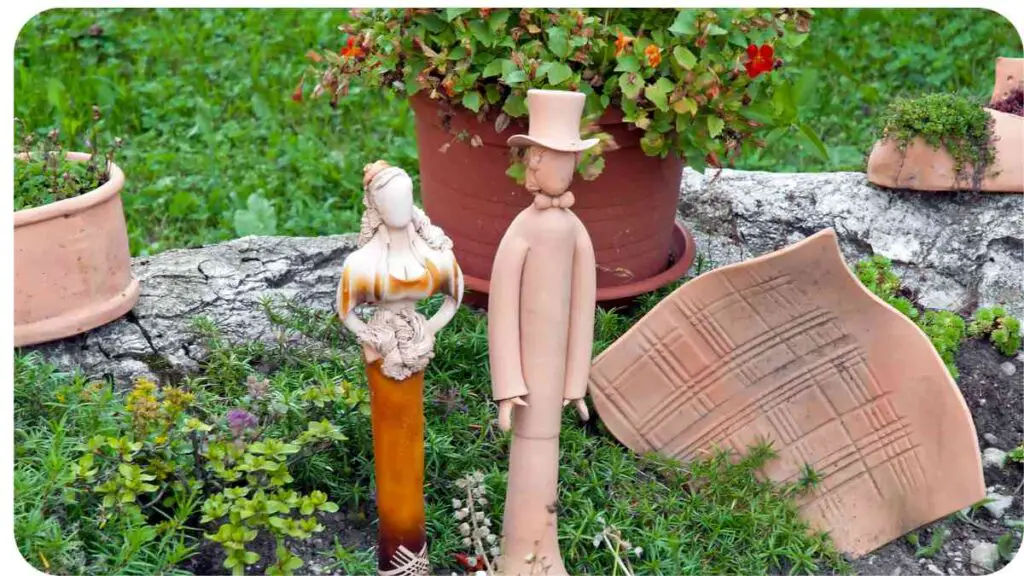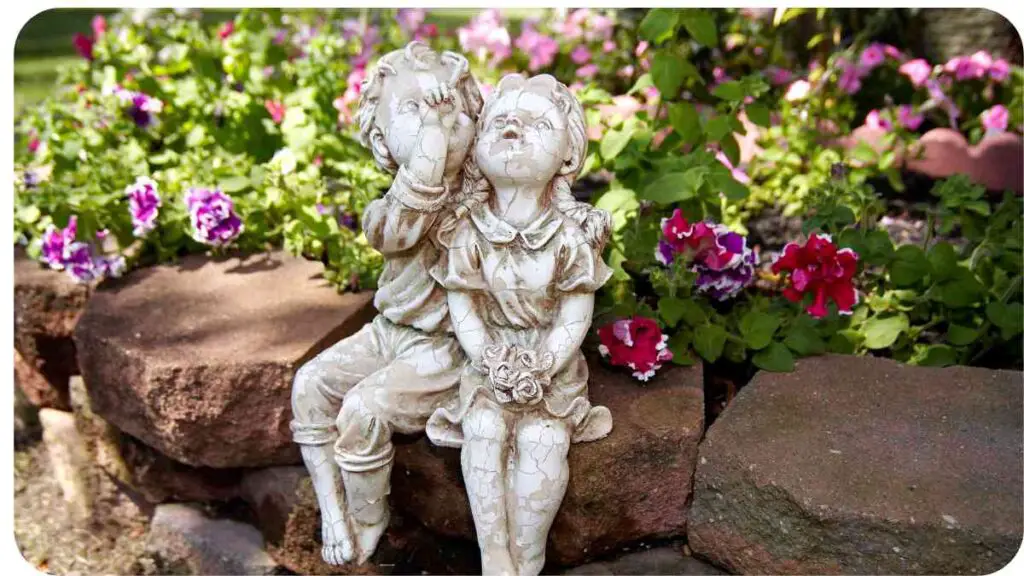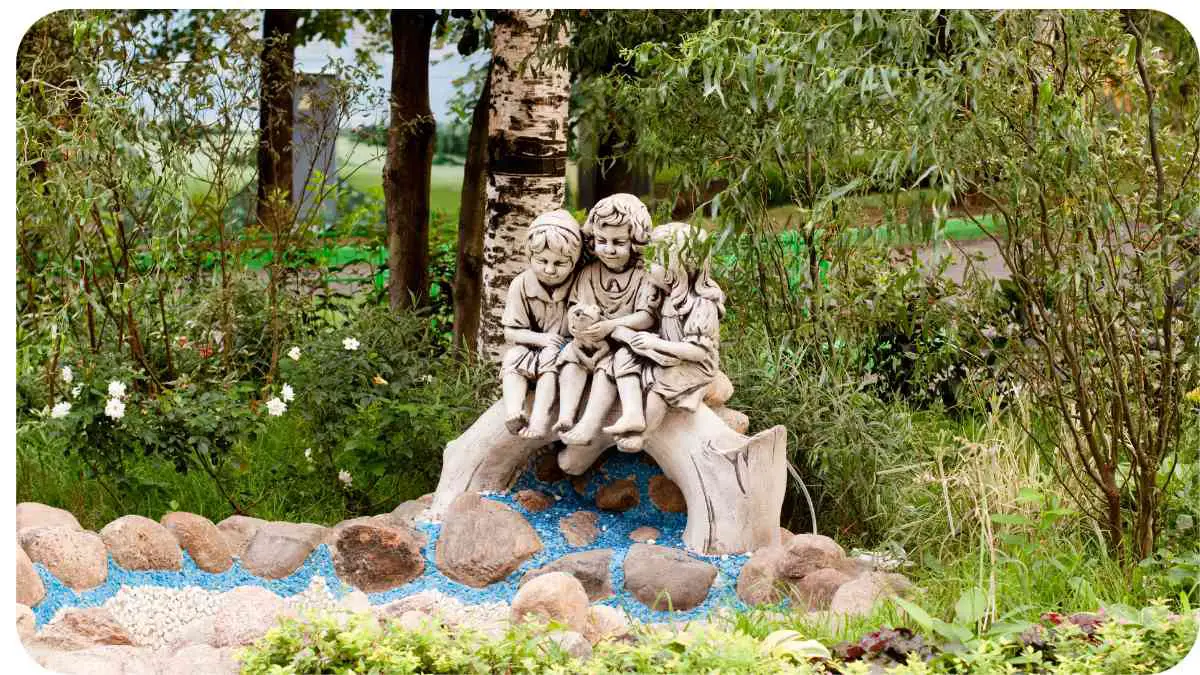Garden statues add charm and personality to any outdoor space, but they’re not immune to wear and tear. If you’ve noticed that your beloved garden statues are crumbling, you’re not alone.
Weather, time, and other factors can take a toll on these decorative pieces. But don’t fret! With a bit of know-how and effort, you can restore them to their former glory. In this guide, we’ll explore how to repair and protect your garden statues, ensuring they remain beautiful for years to come.
| Key Points |
|---|
| Regularly inspect garden statues for damage to catch issues early. |
| Weather exposure, material degradation, and physical damage are common causes of crumbling statues. |
| Clean statues before making repairs to ensure a good bond with repair materials. |
| Use appropriate fillers and sealers based on the statue’s material for effective repairs. |
| Protect statues by choosing a sheltered location and applying protective coatings. |
| DIY repairs are cost-effective for minor damage, but professional help may be needed for extensive issues. |
| Regular maintenance and timely repairs can extend the lifespan of your garden statues. |
Common Causes of Crumbling Garden Statues

Weather Exposure
Weather is one of the biggest culprits behind garden statue damage. Rain, snow, and intense sunlight can erode and degrade materials. For instance, freezing temperatures can cause water trapped in cracks to expand, leading to further damage. To give you an idea, here’s a breakdown of how different weather conditions affect garden statues:
When garden ornaments start showing signs of decay, it’s essential to address the damage early. One common issue is bubbling paint. Learn about the causes and fixes to prevent further deterioration and preserve the beauty of your outdoor features.
| Weather Condition | Impact on Statues |
|---|---|
| Rain | Erosion, mold growth, and color fading |
| Snow | Frost damage and cracking |
| Sunlight | Fading, drying, and material weakening |
Material Degradation
Different materials have varying levels of durability. Stone and concrete statues, while sturdy, can still suffer from surface erosion over time. Resin statues, on the other hand, might become brittle with age. Here’s a quick look at how common materials fare:
| Material | Common Issues |
|---|---|
| Stone | Surface wear and cracking |
| Concrete | Erosion and discoloration |
| Resin | Brittleness and fading |
Physical Damage
Accidents happen! Whether it’s a bump from lawn equipment or a clumsy guest, physical impacts can cause cracks and chips. Regularly checking your statues for signs of physical damage is crucial for timely repairs.
Poor Maintenance
Neglecting regular maintenance can lead to accelerated deterioration. Dirt, grime, and algae buildup can all contribute to a statue’s decline. Keeping up with cleaning and minor touch-ups can prevent more significant issues down the line.
Assessing the Damage
Visual Inspection
Start with a thorough visual inspection. Look for cracks, chips, and other signs of wear. Taking note of these issues will help you determine the extent of the damage and the necessary repairs.
Cracked or crumbling garden statues can be an eyesore, but they’re not the only outdoor elements that suffer over time. Retaining walls often face similar issues due to environmental stress. Discover the common problems and how to fix them before they become major hazards.
Structural Assessment
For a more detailed assessment, tap around the statue. A hollow sound might indicate internal damage. If the statue is leaning or unstable, it may require more extensive repair work.
Identifying Repair Needs
Once you’ve assessed the damage, decide what needs fixing. Small cracks might just need filling, while larger issues might require more involved repairs. Here’s a guide to common repair needs:
| Damage Type | Repair Method |
|---|---|
| Small Cracks | Fill with epoxy or mortar |
| Large Cracks | Reinforce with mesh and mortar |
| Chips | Patch with appropriate filler |
Repairing Crumbling Garden Statues

Cleaning the Statue
Before you start repairs, clean the statue to remove any dirt and grime. Use a mild soap solution and a soft brush to gently scrub the surface. Avoid harsh chemicals that might damage the material further.
Filling Cracks and Holes
For small cracks and holes, use an appropriate filler. Epoxy or mortar works well for concrete and stone statues, while resin fillers are great for resin statues. Ensure the filler matches the statue’s material and color for a seamless repair.
Outdoor features like statues and patio pavers are susceptible to wear and tear. As your hardscape ages, addressing patio paver problems becomes crucial for maintaining your garden’s overall appeal. Learn how to prevent heaving and protect your outdoor investments.
Repainting and Sealing
Once the repairs are dry, you may want to repaint the statue. Use exterior-grade paint that’s suitable for the material of your statue. After painting, apply a sealant to protect the surface from future damage.
Protecting Garden Statues from Future Damage

Choosing the Right Location
Placing your statue in a sheltered area can help protect it from the elements. Avoid spots where it’s exposed to harsh sunlight or direct rainfall.
Applying Protective Coatings
Applying a protective coating can shield your statue from weather damage. Look for coatings designed for your statue’s material. For instance, water-based sealers are ideal for concrete and stone.
Regular Maintenance Tips
Regularly inspect and clean your statue to prevent buildup and damage. Address any issues promptly to avoid more extensive repairs.
DIY vs. Professional Repairs
When to DIY
Small cracks, chips, and basic cleaning are often manageable as DIY projects. If you have some experience with repairs and the damage isn’t extensive, tackling it yourself can be cost-effective.
When to Hire a Professional
For large-scale damage, complex repairs, or if you’re unsure about the repair process, hiring a professional might be the best option. Professionals have the expertise and tools to handle extensive damage and ensure a high-quality repair.
Statue crumbling may not always be due to material degradation. Sometimes, poor drainage in your garden can exacerbate the problem. Discover effective solutions for soggy garden beds to help mitigate water damage and keep your statues intact for longer.
Cost Considerations
DIY Repair Costs
DIY repairs are generally less expensive but require time and effort. Costs will depend on the materials you need, such as fillers and paints. Here’s a rough breakdown:
| Repair Type | Estimated Cost |
|---|---|
| Crack Filler | $10 – $30 |
| Paint and Sealant | $20 – $50 |
| Cleaning Supplies | $5 – $15 |
Professional Repair Costs
Professional repair costs vary based on the extent of the damage and the service provider. Typically, you might expect to pay:
| Repair Type | Estimated Cost |
|---|---|
| Minor Repairs | $50 – $100 |
| Major Repairs | $150 – $300 |
| Restoration Services | $300 – $600+ |
Real-World Examples
Successful DIY Repairs
I once helped a friend restore an old concrete garden gnome that had seen better days. With some epoxy, paint, and a lot of elbow grease, we brought it back to life. It was a rewarding project and saved a significant amount compared to professional services.
Professional Repair Success Stories
I’ve also seen stunning results from professional restorers. For instance, a statue that had severe damage was expertly restored by a local specialist, and it now looks as good as new. It’s a great option if you’re dealing with significant damage or want a perfect finish.
If you’ve noticed your garden statues or pathways sinking, it might not be just age that’s causing the problem. Learn about effective remedies and recommendations to prevent sinking issues and protect your outdoor landscape from further damage.
Further Reading
How to Repair Garden Statues
A detailed guide on repairing garden statues, including common issues and step-by-step instructions for various materials.
How To Restore Statues
Explore various techniques for restoring statues, from cleaning to fixing damage, with practical advice for DIY enthusiasts.
How to Fix Cracked Garden Statue
Find specific methods for fixing cracks in garden statues, including materials and tools needed for a successful repair.
FAQs
How often should I inspect my garden statues?
Inspect your garden statues at least twice a year to check for signs of damage and ensure they are well-maintained.
Can I use regular paint on garden statues?
No, it’s best to use exterior-grade paint designed for the material of your statue to ensure durability and weather resistance.
What’s the best way to clean a stone statue?
Clean a stone statue with a mild soap solution and a soft brush. Avoid abrasive cleaners that could damage the surface.
How do I prevent frost damage to my statues?
To prevent frost damage, place statues in a sheltered location and apply a protective coating that can help shield them from freezing temperatures.
When should I consider professional repairs?
Consider professional repairs if the damage is extensive, if you’re unsure about the repair process, or if you want a high-quality finish.

Hi! My name is Hellen James, and I’m a landscape designer in Los Angeles. I’ve been working with homeowners and businesses to help them improve the look of their properties for over 10 years.

